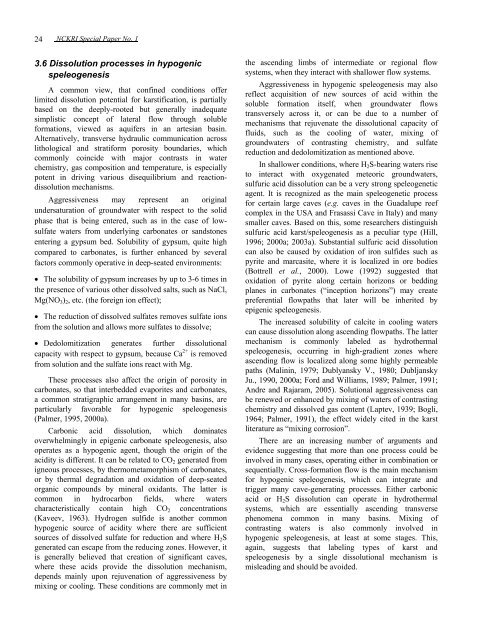Download PDF - Speleogenesis
Download PDF - Speleogenesis
Download PDF - Speleogenesis
Create successful ePaper yourself
Turn your PDF publications into a flip-book with our unique Google optimized e-Paper software.
24<br />
NCKRI Special Paper No. 1<br />
3.6 Dissolution processes in hypogenic<br />
speleogenesis<br />
A common view, that confined conditions offer<br />
limited dissolution potential for karstification, is partially<br />
based on the deeply-rooted but generally inadequate<br />
simplistic concept of lateral flow through soluble<br />
formations, viewed as aquifers in an artesian basin.<br />
Alternatively, transverse hydraulic communication across<br />
lithological and stratiform porosity boundaries, which<br />
commonly coincide with major contrasts in water<br />
chemistry, gas composition and temperature, is especially<br />
potent in driving various disequilibrium and reactiondissolution<br />
mechanisms.<br />
Aggressiveness may represent an original<br />
undersaturation of groundwater with respect to the solid<br />
phase that is being entered, such as in the case of lowsulfate<br />
waters from underlying carbonates or sandstones<br />
entering a gypsum bed. Solubility of gypsum, quite high<br />
compared to carbonates, is further enhanced by several<br />
factors commonly operative in deep-seated environments:<br />
The solubility of gypsum increases by up to 3-6 times in<br />
the presence of various other dissolved salts, such as NaCl,<br />
Mg(NO3)2, etc. (the foreign ion effect);<br />
The reduction of dissolved sulfates removes sulfate ions<br />
from the solution and allows more sulfates to dissolve;<br />
Dedolomitization generates further dissolutional<br />
capacity with respect to gypsum, because Ca 2+ is removed<br />
from solution and the sulfate ions react with Mg.<br />
These processes also affect the origin of porosity in<br />
carbonates, so that interbedded evaporites and carbonates,<br />
a common stratigraphic arrangement in many basins, are<br />
particularly favorable for hypogenic speleogenesis<br />
(Palmer, 1995, 2000a).<br />
Carbonic acid dissolution, which dominates<br />
overwhelmingly in epigenic carbonate speleogenesis, also<br />
operates as a hypogenic agent, though the origin of the<br />
acidity is different. It can be related to CO2 generated from<br />
igneous processes, by thermometamorphism of carbonates,<br />
or by thermal degradation and oxidation of deep-seated<br />
organic compounds by mineral oxidants. The latter is<br />
common in hydrocarbon fields, where waters<br />
characteristically contain high CO2 concentrations<br />
(Kaveev, 1963). Hydrogen sulfide is another common<br />
hypogenic source of acidity where there are sufficient<br />
sources of dissolved sulfate for reduction and where H2S<br />
generated can escape from the reducing zones. However, it<br />
is generally believed that creation of significant caves,<br />
where these acids provide the dissolution mechanism,<br />
depends mainly upon rejuvenation of aggressiveness by<br />
mixing or cooling. These conditions are commonly met in<br />
the ascending limbs of intermediate or regional flow<br />
systems, when they interact with shallower flow systems.<br />
Aggressiveness in hypogenic speleogenesis may also<br />
reflect acquisition of new sources of acid within the<br />
soluble formation itself, when groundwater flows<br />
transversely across it, or can be due to a number of<br />
mechanisms that rejuvenate the dissolutional capacity of<br />
fluids, such as the cooling of water, mixing of<br />
groundwaters of contrasting chemistry, and sulfate<br />
reduction and dedolomitization as mentioned above.<br />
In shallower conditions, where H2S-bearing waters rise<br />
to interact with oxygenated meteoric groundwaters,<br />
sulfuric acid dissolution can be a very strong speleogenetic<br />
agent. It is recognized as the main speleogenetic process<br />
for certain large caves (e.g. caves in the Guadalupe reef<br />
complex in the USA and Frasassi Cave in Italy) and many<br />
smaller caves. Based on this, some researchers distinguish<br />
sulfuric acid karst/speleogenesis as a peculiar type (Hill,<br />
1996; 2000a; 2003a). Substantial sulfuric acid dissolution<br />
can also be caused by oxidation of iron sulfides such as<br />
pyrite and marcasite, where it is localized in ore bodies<br />
(Bottrell et al., 2000). Lowe (1992) suggested that<br />
oxidation of pyrite along certain horizons or bedding<br />
planes in carbonates (“inception horizons”) may create<br />
preferential flowpaths that later will be inherited by<br />
epigenic speleogenesis.<br />
The increased solubility of calcite in cooling waters<br />
can cause dissolution along ascending flowpaths. The latter<br />
mechanism is commonly labeled as hydrothermal<br />
speleogenesis, occurring in high-gradient zones where<br />
ascending flow is localized along some highly permeable<br />
paths (Malinin, 1979; Dublyansky V., 1980; Dubljansky<br />
Ju., 1990, 2000a; Ford and Williams, 1989; Palmer, 1991;<br />
Andre and Rajaram, 2005). Solutional aggressiveness can<br />
be renewed or enhanced by mixing of waters of contrasting<br />
chemistry and dissolved gas content (Laptev, 1939; Bogli,<br />
1964; Palmer, 1991), the effect widely cited in the karst<br />
literature as “mixing corrosion”.<br />
There are an increasing number of arguments and<br />
evidence suggesting that more than one process could be<br />
involved in many cases, operating either in combination or<br />
sequentially. Cross-formation flow is the main mechanism<br />
for hypogenic speleogenesis, which can integrate and<br />
trigger many cave-generating processes. Either carbonic<br />
acid or H2S dissolution can operate in hydrothermal<br />
systems, which are essentially ascending transverse<br />
phenomena common in many basins. Mixing of<br />
contrasting waters is also commonly involved in<br />
hypogenic speleogenesis, at least at some stages. This,<br />
again, suggests that labeling types of karst and<br />
speleogenesis by a single dissolutional mechanism is<br />
misleading and should be avoided.
















